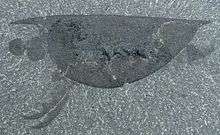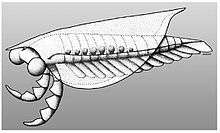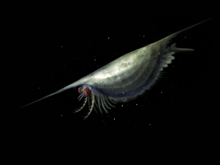Isoxys
Isoxys (meaning "equal surfaces") is a genus of extinct, pelagic bivalved arthropod; the various species may have been roam-swimming predators.[3] It had a pair of large spherical eyes (which are the most commonly preserved feature of the soft-bodied anatomy),[1] and two large appendages[3] It is possible that these appendages are homologous to the great appendages of radiodonts and megacheirans.[4]


| Isoxys | |
|---|---|
 | |
| Isoxys volucris of the Sirius Passet biota | |
| Scientific classification | |
| Kingdom: | |
| Phylum: | |
| Family: | Isoxidae |
| Genus: | Isoxys Walcott, 1890 |
| Species | |
| |
Ecology
Isoxys was abundant in tropical seas,[5] and may have had a global distribution.[3] Eyes of different specimens appear to have been adapted to different light intensities; one specimen of I. auritus was either crepuscular in shallow water, or lived in waters around 140 m below the sea surface; whereas another was morphologically adapted to a diurnal light intensity in shallow waters.[6] It is likely that Isoxys was a visual predator that hunted swimming above the seafloor. It had powerful prehensile frontal appendages and large spherical eyes. Isoxys could propel itself by the beating possibly 14 flippered swimming legs (setose exopods) and steer with a flap-like tail (or telson).[3]
Species
There are a number of species of Isoxys.[7] I. volucris is the most abundant in the Sirius Passet locality; I. auritus is found in China.[5] In addition to a single specimen of I. longissimus, 163 specimens of I. acutangulus – making a total of 164 specimens of Isoxys are known from the Greater Phyllopod bed, where they comprise 0.31% of the community.[8]
Taxonomy
Isoxys is thought to be one of the basalmost known arthropods, more basal than members of Megacheira but more derived than members of Radiodonta.[9]
See also
- Arthropod
- Cambrian explosion
- Chengjiang biota
External links
- "Isoxys acutangulus". Burgess Shale Fossil Gallery. Virtual Museum of Canada. 2011.
References
- García-Bellido, D.; Vannier, J.; Collins, D. (2009). "Soft-part preservation in two species of the arthropod Isoxys from the middle Cambrian Burgess Shale of British Columbia, Canada" (PDF). Acta Palaeontologica Polonica. 54 (4): 699. doi:10.4202/app.2009.0024.
- Liu, Q.; Luo, H.-L.; Chen, L.-Z.; Lu, S.-X. (2006). "Panlongia, a new trilobitomorph genus from the Lower Cambrian, Kunming, Yunnan". Acta Palaeontologica Sinica. 45: 384–392.
- Vannier, J.; Garcia-Bellido, C.; Hu, X.; Chen, L. (Jul 2009). "Arthropod visual predators in the early pelagic ecosystem: evidence from the Burgess Shale and Chengjiang biotas". Proceedings: Biological Sciences. 276 (1667): 2567–2574. doi:10.1098/rspb.2009.0361. ISSN 0962-8452. PMC 2686666. PMID 19403536.
- Aria, Cédric; Zhao, Fangchen; Zeng, Han; Guo, Jin; Zhu, Maoyan (December 2020). "Fossils from South China redefine the ancestral euarthropod body plan". BMC Evolutionary Biology. 20 (1): 4. doi:10.1186/s12862-019-1560-7. ISSN 1471-2148. PMC 6950928. PMID 31914921.
- Stein, M.; Peel, J. S.; Siveter, D. J.; Williams, M. (2009). "Isoxys (Arthropoda) with preserved soft anatomy from the Sirius Passet Lagerstätte, lower Cambrian of North Greenland". Lethaia. 43 (2): 258. doi:10.1111/j.1502-3931.2009.00189.x.
- Schoenemann, B.; Clarkson, E. N. K. (2010). "Eyes and vision in the Chengjiang arthropod Isoxys indicating adaptation to habitat". Lethaia. 44 (2): no. doi:10.1111/j.1502-3931.2010.00239.x.
- Julien Kimmig & Brian R. Pratt (2015). "Soft-bodied biota from the middle Cambrian (Drumian) Rockslide Formation,Mackenzie Mountains, northwestern Canada". Journal of Paleontology. 89 (1): 51–71. doi:10.1017/jpa.2014.5.
- Caron, Jean-Bernard; Jackson, Donald A. (October 2006). "Taphonomy of the Greater Phyllopod Bed community, Burgess Shale". PALAIOS. 21 (5): 451–65. doi:10.2110/palo.2003.P05-070R. JSTOR 20173022.
- Legg, David A.; Vannier, Jean (October 2013). "The affinities of the cosmopolitan arthropod Isoxys and its implications for the origin of arthropods". Lethaia. 46 (4): 540–550. doi:10.1111/let.12032.